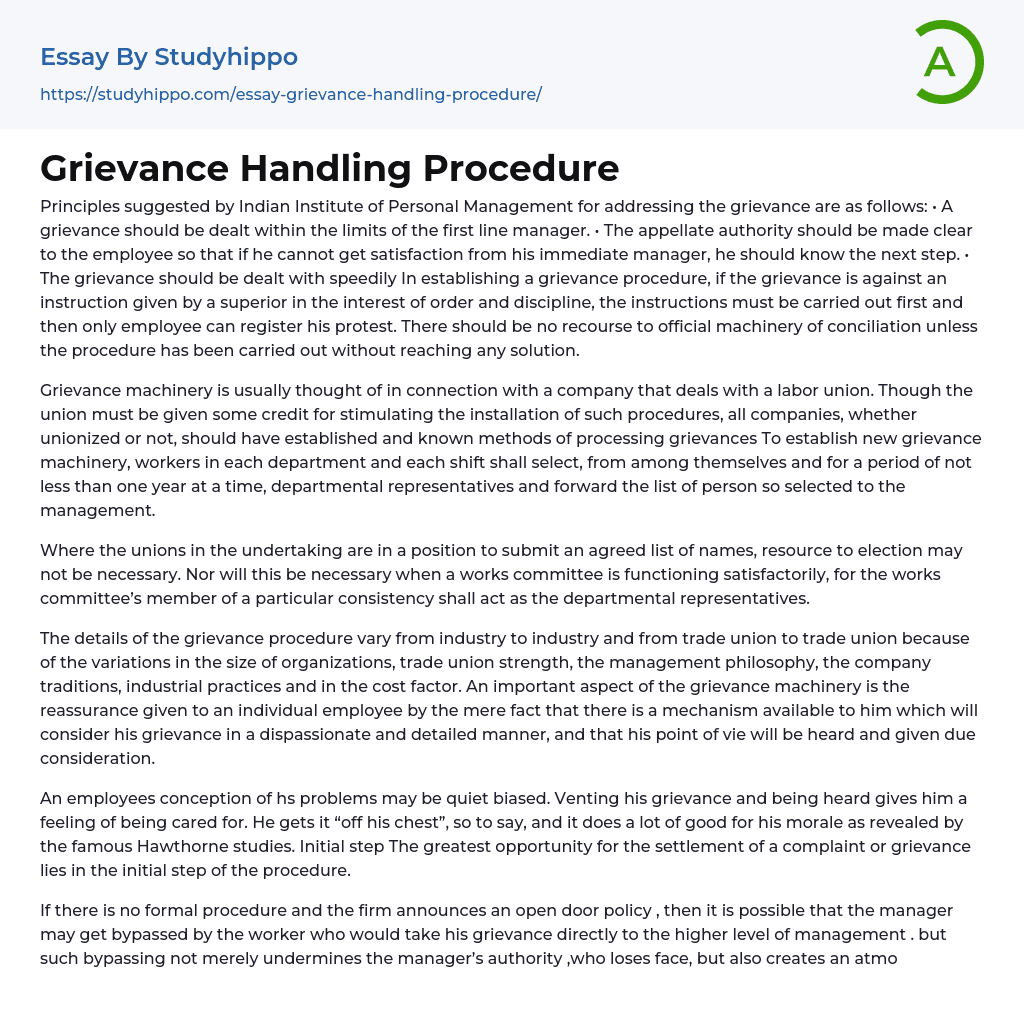The Indian Institute of Personal Management provides guidelines for addressing grievances, which include resolving them with the authority of the first line manager, informing employees of higher authorities to approach if satisfaction is not achieved through their immediate manager, and promptly resolving grievances. When implementing a grievance procedure, if an employee has a complaint against a superior's instruction related to order and discipline, they should initially comply with the directive before protesting. Official mediation should only be sought after all other unsuccessful attempts at resolution have been exhausted.
The grievance machinery is typically associated with companies that have labor unions. However, all companies, regardless of whether they are unionized or not, should have well-known methods for dealing with grievances. In order to create new grievance machinery, employees in each depart
...ment and shift will choose representatives from among themselves for a minimum duration of one year. The list of selected individuals will then be submitted to management.
The submission of an agreed list of names by the unions may eliminate the need for an election in the undertaking. Additionally, if a works committee is successfully operating, the representative from that committee will act as the departmental representative without the need for further action.
The specifics of the grievance procedure differ depending on the industry and trade union. Factors such as organization size, trade union strength, management philosophy, company traditions, industrial practices, and cost influence these variations. However, an important aspect of the grievance machinery is the reassurance it provides to employees that there is a mechanism available to them. This mechanism will consider their grievances in an objective and thorough manner, ensuring tha
their perspective is heard and given appropriate consideration.
The initial step of the procedure offers the greatest opportunity for settling an employee's biased conception of their problems. Venting their grievance and being heard provides them with a sense of being cared for. It allows them to get it "off their chest", benefiting their morale as seen in the Hawthorne studies.
Employees can bypass their manager and take their complaint directly to higher management due to the lack of a formal procedure and an open door policy. This undermines the authority of the manager, creating a competitive environment where both parties aim to discredit each other.
The next step in the management aspect of the procedure, as indicated by the figure, is to present the disagreement to middle management. Involving managers at different levels in the grievance process has two advantages. Firstly, interpersonal interaction and shared understanding assist in breaking down social divisions between different groups. Secondly, the problem-solving approach unites various organizational levels as a team to collectively address issues that impact both workers and managers.
It is crucial to make sure that line management takes on the main role in resolving grievances. In some organizations, the Personnel department is involved in the process as a decision-making authority. On the union side, higher personnel in the union hierarchy represent intermediate levels. In many organizations, the business agent, who is a full-time negotiation specialist for the union, handles the intermediate and occasionally the final step.
The union often outmaneuvers management because business agents specialize in union management negotiations and it is their full-time job, unlike management. Line managers consider grievance processing
a minor and distasteful duty. As a result, decisions about grievances are often made by the staff personnel department.
Typically, discussions about grievances require dialogue between the company and the union, with involvement from high-ranking representatives on both sides. The company's team may include the President, a Vice-president, or a senior industrial relations executive. Similarly, the union's participants might consist of the local union president, Union Executive Committee members, or an International union representative. Reaching an agreement at this level can be challenging due to conflicting interests.
- Profession essays
- Labour Economics essays
- Occupational Safety And Health essays
- Pension essays
- Salary essays
- Strike Action essays
- Wage essays
- Career essays
- Workplace essays
- Homeless essays
- Working Together essays
- Career Path essays
- Hunter essays
- Farmer essays
- Nurse essays
- Pilot essays
- Professionalism essays
- Doctor essays
- Discipline essays
- Police Officer essays
- Labor essays
- Social Work essays
- Model essays
- Architect essays
- Engineer essays
- Administration essays
- Stakeholders essays
- Teamwork essays
- Caregiver essays
- Public Administration essays
- Raising Minimum Wage essays
- Interview essays
- Job Interview essays
- Career Choice essays
- Career Goals essays
- Portfolio essays
- Community Service essays
- Work-Life Balance essays
- Performance Appraisal essays
- Job essays
- Employee essays
- Skills essays
- Service essays
- Vocation essays
- Internship essays
- Work Experience essays
- Duty essays
- Dream Job essays
- Career Plan essays
- Working Time essays




